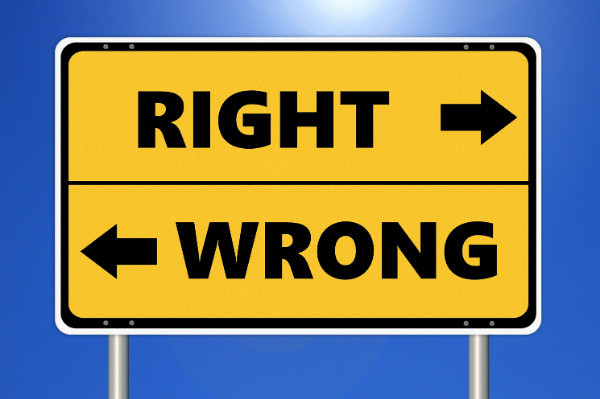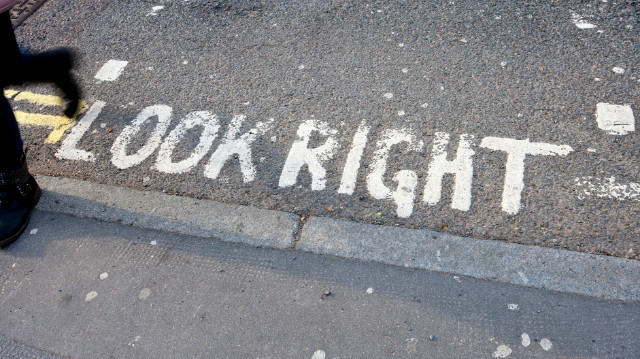The English word “right” actually has a lot of different meanings and uses. This can make it tricky to know which word to use in Japanese for each of these situations. That’s why I’m going to explain how to say right in Japanese.
There are four sections below, each one focusing on a different English usage of this word, along with the Japanese equivalent that should be used.
Let’s get started with the simplest one first and then get more complicated as we proceed.
When Right Means Direction
The first word for right has to deal with direction. The best way is to use in combination with its opposite, left.
In Japanese, this word for right is 右 (migi). I read the origins of this word when I was learning it and the book told me that the two lines in the top left corner represent a person’s hand. The square in the bottom right corner represents a person’s mouth.
Since most people are right-handed, they typically use their right hand to eat. This is a pretty good way to remember this kanji’s meaning. Most people use their right hand to put food in their mouth.
As for the opposite, let’s take a look at it now.
The Japanese word for left is 左 (hidari) which has a similar construction to the last kanji we just saw. This one also has those two lines that represent a person’s hand, but then we have this “capital-i” looking symbol.
The book I read said that this was a carpenter’s tool and that people would typically hold the tool in their left hand while they were working and measuring things.
So a good way to remember this kanji’s meaning is that people hold tools in their left hand. I like to imagine that they are using the tool to measure something, and that they have a pencil or pen in their right hand that they are using to mark a length.
If learning kanji through their original meaning’s like this is something you want to learn more about, then check out my review of The World of Kanji.
It teaches all of the daily use kanji needed for literacy through this method.
When Right Means Privilege
People in every country have “rights” as to what they can expect to receive since they are a member of that society. It’s not something that people think about every day, but it’s an important aspect of the world we live in.
That being said, when you start reading books or watching shows that center around the law, this word begins to pop up all over the place.
The Japanese word for this kind of right is 権利 (kenri)
- 権利と義務について
- kenri to gimu ni tsuite
- about rights and obligations
That being said, it is also pretty common to see just the kanji 権 (ken) used as a suffix on other words. When this happens, it brings the meaning of “the right to do…” to whatever it is attached to.
Let’s say that you somehow earned “the right to negotiate” with a particular company (or country) for your business. In that case, you would add on 権 to the end of the word 交渉 (koushou) for negotiate.
- ~との交渉権
- ~ to no koushou ken
- right to negotiate with~
When Right Means Correct

Another way that we use the word right in English is to tell people that something is correct. I’m not talking about “doing the right thing” (although this word can be used for that as well) but rather the opposite of the word wrong.
The Japanese adjective that we want this time is 正しい (tadashii). This is the plain form, but when you need to be polite you can simply add on the Japanese word です (desu) to the end.
- この方法は正しいですか。
- kono houhou wa tadashii desu ka?
- Is this method correct?
Since this word is an i-adjective, we can inflect it to say things like “that’s not correct” whenever we need to tell someone that they are doing something the wrong way, or when their answer isn’t the right one.
To do that, we just replace the final い with くない to get 正しくない (tadashi kunai). One thing to keep in mind is that most Japanese people will speak fast enough to “de-voice” the vowel sound between the し and the く in this word.
To English ears, it will sound more like “tadashh kunai” as if that “i” sound completely disappeared.
How To Say, I Know Right!
When you are talking with your friends, it’s common for them to say something that you wholeheartedly agree with. In cases like these, you want to share how you feel and a common phrase that Americans use is “I know, right!”
You can do the same thing in Japanese with the help of a couple of phrases. They all mean the same thing, they just have some different feels to them and are structured a little bit differently.
The first one is ですよねー (desu yo nee) which is common used by girls when they are speaking with friends and family. The equivalent phrase that a guy would normally use is だよなー (da yo naa).
Pay attention to the elongated vowel at the end of each of those phrases. This is very similar to the tone that an English speaker would use when they say the “right” part of that phrase. It adds emotional emphasis to the phrase.
Two other ways that you can say this are with the polite and casual forms this next word.
The word is でしょう (deshou) and is a common expression for “right?” in Japanese. When people use it to agree with what someone just said, they typically shorten the ending vowel (the opposite from the earlier words) to just でしょ (desho).
This above word is more polite, so it is typically the word of choice for ladies. The men typically try to sound more masculine when they speak among people they know well, so they will often opt for the casual version.
That would be だろう (darou) which means the exact same thing as でしょう. And like before, when a guy wants to show his agreement, he will usually shorten the ending vowel to just だろ (daro).
Questions? Comments?
That’s all I’ve got for today’s lesson on the many different Japanese words for right.
If you’ve got any questions or comments that you would like to make, then please do so by entering them into the area below.
Thanks for reading!
Further Resources for Learning Japanese:
#3 Get My eBook (Secrets to Learning Japanese) for Free

またね!
